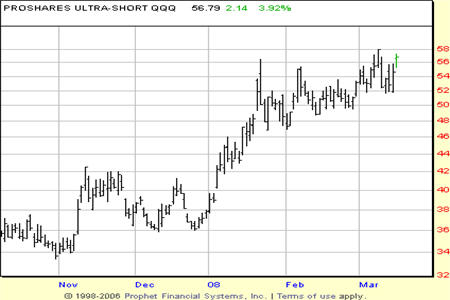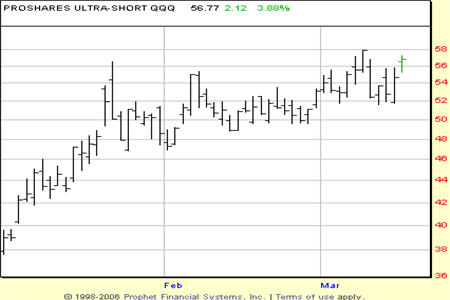Why Is This ETF Up 43.9% for the Year?
What exchange-traded fund (a) is up more than 40% year-to-date and (b) includes among its holdings some of the biggest stocks in the
NASDAQ 100 like Apple
(
AAPL |
Quote |
Chart |
News |
PowerRating), Microsoft
(
MSFT |
Quote |
Chart |
News |
PowerRating), Google
(
GOOG |
Quote |
Chart |
News |
PowerRating), Qualcomm
(
QCOM |
Quote |
Chart |
News |
PowerRating) and Research in Motion
(
RIMM |
Quote |
Chart |
News |
PowerRating)?
Not sure yet? Let’s add one more clue. This ETF (c) provides a leveraged opportunity for traders to bet against the markets.
If you guessed the UltraShort QQQ
(
QID |
Quote |
Chart |
News |
PowerRating), then you’ve guessed right. This product from the ProShares family of exchange traded funds is up nearly 44% as of Friday, March 7th,
and with the NASDAQ down more than 1.5% on the following Monday as I write, is likely to make even more money for traders before its run is through.
Exchange-traded funds like the UltraShort QQQ are called “inverse ETFs.” This means that these exchange-traded funds are designed to match the performance of the underlying index–in this case the
NASDAQ 100 tracked by the QQQQ–on an inverse basis. In other words, with an inverse ETF, for every point the QQQQ goes down, an inverse ETF based on the QQQQ would go up by one point. These kinds of ETFs have become increasingly popular among traders, many of whom would rather buy a liquid asset like an exchange-traded fund in order to bet against the market (or to hedge) than try their hand at short-selling.
The UltraShort QQQ, however, adds an even more interesting wrinkle. Rather than being merely an inverse fund, the UltraShort QQQ is also a leveraged exchange-traded fund. By being leveraged 2 to 1, an ETF like the UltraShort QQQ gets much more “bang for the buck” compared to a regular inverse exchange-traded fund.

For example, if the QQQQ moved down by two points, an inverse ETF based on the QQQQ would move up by two points. But with a leveraged, inverse fund like the QID, the UltraShort QQQ would actually be up four points.
The implications for traders are huge. Many investors like exchange-traded funds because of their low volatility. But this relatively low volatility compared to stocks can be a problem for short-term stock traders, who rely on the relatively high volatility of stocks in order to make money trading. By using leveraged ETFs, traders get the benefit of a reliable, low volatility ETF on the one hand, but with the sort of 2-to-1 leverage that can make even a modest move in the market the leveraged ETF is tracking become sizable gain for a trader buying and selling that fund.
Consider three traders. One trader shorted the QQQQ at the beginning of the year. Another trader bought an inverse ETF based on the QQQQ. A third trader also bought an inverse exchange-traded fund. But rather than buy a vanilla inverse exchange-traded fund, our third trader actually bought the UltraShort QQQ, a leveraged, inverse ETF.
All traders placed their trades as of the close on January 2, 2008, and were open as of this writing on March 17, 2008.
Trader #1
Short QQQQ at 50.55
Last: 41.35
Gain (Loss): 18.20%
Trader #2
Long PSQ (inverse QQQQ) at 54.18
Last: 65.76
Gain (Loss): 21.37%
Trader #3
Long QID (leveraged, inverse QQQQ) at 39.02
Last: 56.77
Gain (Loss): 45.49%
As we can see, all three traders did very well betting against the NASDAQ 100 in the first few months of the year. But we can also see that not only did the inverse QQQQ trader outperform the short-QQQQ trader by more than 300 basis points, but look at the performance of the trader you used the UltraShort QQQ: a return of more than 45%, more than double that of the inverse QQQQ trader.

Leverage, as the saying goes, is a double-edged sword. If the NASDAQ 100 had rallied strongly in 2008, then all three traders would have underperformed, and the biggest losses would come from the portfolio that has used the greatest leverage.
But for traders with sound trading methods and an understanding of when to buy and when to sell, leverage can be the gift that turns a relatively uninspiring trade into a true, profit-producing winner. Leverage, considered this way, is a lot like a fast and powerful car: if you do not know how to drive, you can run into trouble. But if you know and understand the responsibilities involved, leverage–just like that fast and powerful automobile–can get you where you want to be very, very quickly.
Traders everywhere are becoming more and more interested in the opportunities that lie in both short and leveraged short exchange-traded funds. We’ve published a number of articles on leveraged ETFs here at TradingMarkets, including this latest one from Toni Turner which we featured early in March, “How to Use Inverse ETFs for Profit and to Hedge.” If you’re curious about what leveraged and leveraged short ETFs can do for you and your trading, Turner’s article is a great place to start.
David Penn is Senior Editor at TradingMarkets.com.
